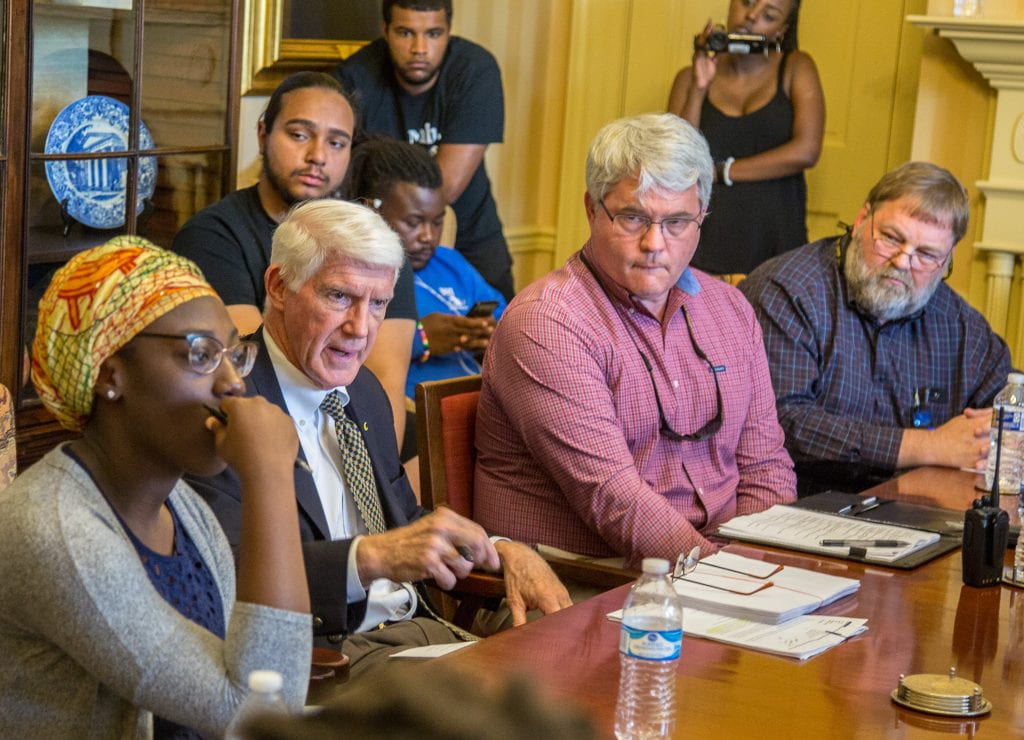BY SARAH HOLLOWAY – EDITOR-IN-CHIEF
*the term “ally” is employed in this article because it was the term used by the group organizing the sit in. It is not meant to imply the binary that anyone who was in support of the event is an ally and anyone who wasn’t in support was not an ally, rather it is simply used to describe those that participated in the sit in alongside the organizing group.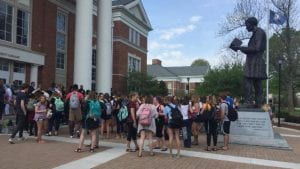
At 11:15 on Wednesday May 2, 2018, a large population of Centre College students, faculty, and staff gathered under the Lincoln statue. Led by a coalition of black students, the movement called for allies* of this group to support their efforts in demanding changes to school policy in the Athletic Department, Department of Public Safety, Dining Services, Diversity Office, President’s Office, and Title IX Office. Allies stood together and listened to the goals and guidelines of the student leaders as they passed out packets of information containing frequently asked questions, the comprehensive list of demands, and sections of the student handbook outlining individual rights.
“Social change does not lie in the hands of one individual,” said Lorna Closeil, a sophomore at Centre College and one of the sit in coordinators. “The people who were making flyers were eaders, the people who were coordinating food were leaders, the people that sat down at Cowan tables petitioning were leaders—heck our allies who sat down for our cause are leaders. We wanted to be intentional about not limiting our perception of leadership to the person in the front of the room or the loudest person in the room. Leadership is multifaceted.”
Participants marched from the statue to Old Centre, greeting administrators that worked there with a flood of bodies that quietly took residence inside the building wherever they could find a seat. This is where the majority of them would stay for the next 53 hours until nearly every demand was met.
The distribution of flyers across campus and on social media emblazoned with “#It’s Time” began the process of rallying support for the cause. Featuring some of the group’s most pressing demands and an edited depiction of an upside-down Centre Colonel, the flyer called for action and solidarity through Martin Luther King Jr.’s quote “We are now faced with the fact that tomorrow is today. We are confronted with the fierce urgency of now.”
The decision to organize a sit in was to address racially-derived concerns that organizers believed had long been overlooked by the administration of the college. Unfortunately, no institution is completely free of these problems, and Centre is no exception. For years, students of color have been expressing concerns to administration and tensions came to a head in a way that resulted in an unprecedented response from students.
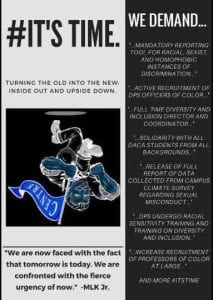 “It was a series of incidents, it wasn’t just one thing,” said Leah Kelly, a junior and one of the many organizers of the event. “Frankly, black students on campus were hurting, and it got to the point where we would go through the ‘correct channels’ that are supposed to help us, but there was still no transparency and no accountability.”
“It was a series of incidents, it wasn’t just one thing,” said Leah Kelly, a junior and one of the many organizers of the event. “Frankly, black students on campus were hurting, and it got to the point where we would go through the ‘correct channels’ that are supposed to help us, but there was still no transparency and no accountability.”
These incidents spurred a lot of discussion on campus; several forums were held and opened up to the community, initiated by Associate Vice President for Academic Affairs and Diversity Initiatives Dr. Rodmon King. These forums were very helpful and greatly appreciated by many as they sought to meet people where they were in their understanding and experiences with the events, but several students felt that more needed to be done.
Centre’s administration was responsive to the events; several administrators attended the forums, including a member of the Board of Trustees as well as President Roush and Susie. President Roush also sent out an email outlining new campus initiatives, including a more permanent Coordinator of Diversity and Inclusion Programming, hiring another counselor at Parsons focusing on multicultural issues, expanding Title IX to address diversity and inclusion, and creating a multicultural center.
These initiatives are all important steps in working towards a more inclusive campus, but in order to ensure real progress, students of color took their own initiatives to address the problems they saw at Centre. As seen in the “Statement of Intent” released by the group of organizers, “…we acknowledge that Centre College has taken positive and important first steps toward meeting some of the unmet needs of marginalized students. The following demands are in the spirit of sustaining the momentum, increasing transparency, and providing more intentional next steps in creating an inclusive environment. Thus, more accurately reflecting the compassionate, understanding, and kind community that Centre College aims to be.”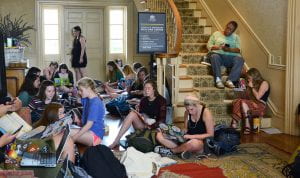
To read the proposed list of demands, click here.
Old Centre was overtaken by students—pillows, blankets, tents, food, and laptops filled the space as each demand was addressed in the negotiating room. An outside support system was organized by professors, students, and alumni that would coordinate food deliveries catering to the diverse dietary needs of participants as well monetary donations and tents and blankets.
“I have never felt more supported by the Centre College community. After negotiations, it was beautiful to see the tents pitched up outside, people sleeping on the steps of Old Centre, prayer circles outside, and people inside watching movies and engaging in conversations with one another,” Lorna Closeil said.
Patrick Noltemeyer, the Special Assistant to the President and Chief Planning Officer at Centre, was present at almost every negotiating session and even spent the night in Old Centre to ensure the safety of the students. “The sit in last week was a learning opportunity for all of us. As a result of the conversations that took place and the learning that occurred, Centre College will be a stronger institution going forward. The conversations were often difficult, and each of them was important. The work that took place last week was just the beginning, and to make the most of the experience, we must all reflect on our involvement and actions leading up to and during the sit in, and use the knowledge gained from that reflection to make better decisions in the future.”
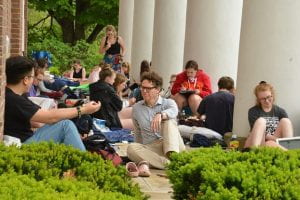 While the sit in served an invaluable role in meeting the needs of many students on campus, there was a lot of pain and trauma involved throughout the process. As with any social movement, there are difficulties and consequences that often go unseen, and it would be irresponsible not to acknowledge this.
While the sit in served an invaluable role in meeting the needs of many students on campus, there was a lot of pain and trauma involved throughout the process. As with any social movement, there are difficulties and consequences that often go unseen, and it would be irresponsible not to acknowledge this.
“The sit-in was powerful, but I believe it also caused harm to many students and staff. I believe the sit-in was absolutely necessary but at times the organization and execution were not always inclusive to all students. It is an unfortunate reality, but I do want to commend the students for standing up for issues that are very real on campus,” said Greg Chery, Centre’s Director of Community Service and the Bonner Program.
According to some sources intimately involved with the planning process, there were unexpected tensions within the organizing group that created another level of marginalization for many. “A lot of things were overlooked, and I think part of that is because people aren’t trained in community organizing. People forget that it’s not just a skill, it’s actually a job,” said Amaryst Parks, a senior and person involved.
Dr. Rodmon King has voiced his concerns, stating “While it cannot be disputed that the sit in resulted in many good outcomes for our community, you cannot get caught in the fallacy of the ends justifying the means. Decisions were made that had dramatic impact, and some people were broken by that.”
Coordinating an event such as the one that took place at Centre involves much more than just logistical work. It created a highly emotional environment that carried a lot of pain for so many—it is hard enough to address these needs as a professional in this field, but even more so as students new to the process.
“As much as the whole movement was about inclusivity and how we can make this a better community for black students, it sometimes left out intersectionality in being inclusive to all different types of black students, as well as moving forward to people of color,” said Parks.
“It reveals the way intersectionality hasn’t proved practicable in these things, it’s an idea that we learn in classes—I can’t think of a day I’ve spent at Centre where I didn’t hear the word ‘intersectionality’—but when you ask people to consider others’ experiences, that same intellectual practice isn’t extended in social reality,” said Siera Hanks, a senior and ally.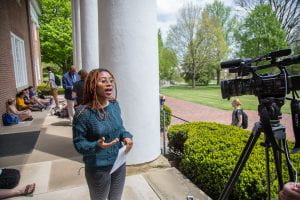
The sit in did a lot to meet the needs of black students on campus, but many acknowledge that moving forward, intersectionality and inclusivity for other groups on campus is paramount. The work accomplished by these student organizers has created a basis for social change that can now help other groups.
“I think it’s so important as allies to take a step back, but it’s also important to critique at the same time in a way that is equitable and not coming from a place of abject privilege and blindness to the problems people face,” said senior and ally Peter O’Donnell. “We’ve never had a foundation like this before and hopefully we move on from this to include other marginalized groups.”
The sit in that took place this semester was the first of its kind in Centre’s 200-year history. It is essential that it be remembered with the truth in which it occurred for each individual: pain, solidarity, disagreement, community, joy, consequences, and progress. It was a learning experience for this institution in so many ways and also produced concrete policy changes that will benefit all students for the future.
“As someone who is about to graduate, I really want people on campus who feel marginalized to know that you can make people listen. Protest is often viewed in such a negative light in this country, but protesting is a right and can be constructive. I want people to find their voice and know that they can say what they need,” said Eliana Paniagua, senior and negotiation participant.
As the semester comes to a close, it is necessary to take this time to reflect on all that has occurred. “My hope is that our campus will have an intentional time of healing. Then, we students, staff, and faculty must address these issues at their root, meaning the culture of our campus as a whole,” said Greg Chery.
